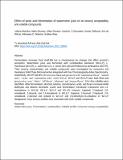Effect of lactic acid fermentation of watermelon juice on its sensory acceptability and volatile compounds

View/
Date
2021-10-01Author
Mandha, Juliana
Shumoy, Habtu
Devaere, Jolien
Schouteten, Joachim
Gellynck, Xavier
de Winne, Ann
Matemu, Athanasia
Raes, Katleen
Metadata
Show full item recordAbstract
Fermentation increases food shelf-life but is characterized by changes that affect product's perception. Watermelon juice was fermented with Lactobacillus plantarum (WJ-LP), L. rhamnosus (WJ-LR), L. casei (WJ-LC), L. brevis (WJ-LB) and Pediococcus pentosaceus (WJ-PP). Their sensory characteristics and volatile compounds were investigated by consumers and Headspace Solid Phase Microextraction integrated with Gas Chromatography-Mass Spectrometry, respectively. WJ-PP and WJ-LB were most liked and perceived with ‘watermelon-flavor’, ‘natural taste’, ‘sweet’ and ‘watermelon-color’ while WJ-LC, WJ-LP and WJ-LR were least liked and perceived as ‘sour’, ‘bitter’, ’off-flavor’, ‘aftertaste’ and ‘intense-flavor’. Fifty-four volatiles were identified. After fermentation, alcohols, ketones, monoterpenes, acids, and furans increased while aldehydes and alkanes decreased. Lactic acid fermentation introduced 4-decanone and 2,3-butanedione in WJ-LB, WJ-LC, WJ-LP and WJ-LR, however, heptanal, 2-heptenal, 2,6-nonadienal, 2-decenal, and 2,4-decadienal in WJ-LC, heptanal, 2-hexenal, 2-heptenal, 2,6-nonadienal, 2-decenal and octanal in WJ-LR and 2,6-dimethyl-2,6-octadiene in WJ-LP disappeared. Juice sensory profiles were associated with their volatile compounds.
URI
https://doi.org/10.1016/j.foodchem.2021.129809https://dspace.nm-aist.ac.tz/handle/20.500.12479/1161
